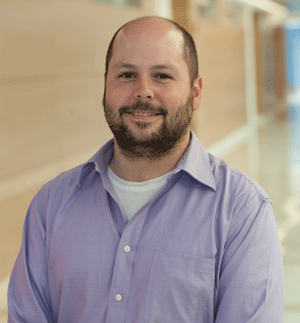 |
|
| Brian Kelch, PhD |
A new model developed by biomedical researcher Brian Kelch, PhD, and colleagues at UMass Medical School explains how the microscopic motor responsible for packing viral DNA into its tiny protective shell generates the speed and force to overcome pressures ten times greater than that of a sealed bottle of champagne. The findings, published in the Proceedings of the National Academy of Sciences, were made using a hardy virus native to super hot hydrothermal vents and may provide a potential new avenue for disabling and killing certain viruses.
“Some viruses, including several that cause cancer, use a molecular motor to grab and package DNA. This motor is among the strongest biological motors known,” said Dr. Kelch, assistant professor of biochemistry & molecular pharmacology. “If these motors were the size of a car, they’d be traveling the equivalent of about 400 mph and have four times the towing capacity of a standard pickup truck.
“From a clinical perspective, if we can find a drug that disables this motor, we can stop a virus from replicating and spreading,” said Kelch. “It’s also possible that this same viral motor can be re-engineered in some clinical instances to potentially deliver gene therapy treatments.”
A unique combination of speed and force is needed to overcome the tremendous pressure generated as the viral DNA is squeezed and condensed into its tiny protein shell called a capsid. Previous research had established that the motor was shaped like a ring, but Kelch’s biochemical experiments were inconsistent with the popular model that had been established.
“It was like a puzzle where the pieces didn’t quite fit together,” said Kelch.
Part of the problem was the virus commonly used to run the experiments was too fragile. It didn’t hold up well to the heat of the experiments and was hard to work with. This resulted in a paucity of usable data. “To run our experiments, we developed a new system using an extra hardy virus found in hydrothermal vents where the temperature is over 150°F,” said Kelch. “These viruses infect bacteria and have a motor similar to those found in herpes viruses that attack humans.”
Employing a combination of high-resolution crystallography, small angle x-ray scattering, biochemical analysis and advanced computer modeling, Kelch and his team were able to generate low-resolution models of what the motor looks like. “We found the same ring-like structure that was identified 10 years ago,” said Kelch, “but the orientation of the motor was the exact opposite of what was previously thought.”
It was believed that the components that powered and moved the motor were arranged on the outside of the ring to allow quick access to the adenosine triphosphate (ATP) molecules that fueled it. Data collected by Kelch, however, showed that these parts were located on the inside of the ring and were connected. This revised model suggests that the ring surrounds the genome and that the components of the motor work in concert to “walk” the DNA into the capsid.
| ; | |
Like pistons driving a powerful pump, the viral motor is made of five “levers” that hand the DNA strand off to each other, effectively walking it around the ring of the motor and pumping it up into the capsid. Burning ATP molecules for fuel, the first lever grabs the DNA strand and moves it along to the next one. As one ATP molecule is burned, the DNA is pushed up into the capsid and the lever returns to its original resting position where it waits for the other levers to push the DNA upward and around the ring again. The motor continues this process, moving DNA around the inside of the ring and up until the viral genome fills the capsid.
Initial funding for the project came from a Worcester Foundation for Biomedical Research grant and the Pew Scholars Program in the Biomedical Sciences. The next step for Kelch and colleagues will be to get a high-resolution image of the motor in action the new electron cryo-microscopy (cryo-EM) at UMMS that was recently purchased with the help of a $5 million grant from the Massachusetts Life Sciences Center.
“As you can imagine, it is very difficult to get a high-resolution image of the motor in action because it doesn’t like to hold still; it has been evolved to move,” said Kelch. “This breakthrough technology will allow us to do just that. From there, we can start talking about taking it apart and re-engineering it to learn precisely how it’s constructed.”
Related story on UMassMedNow
Massachusetts Life Sciences Center announces $5M award to UMMS for Cryo-Electron Microscope